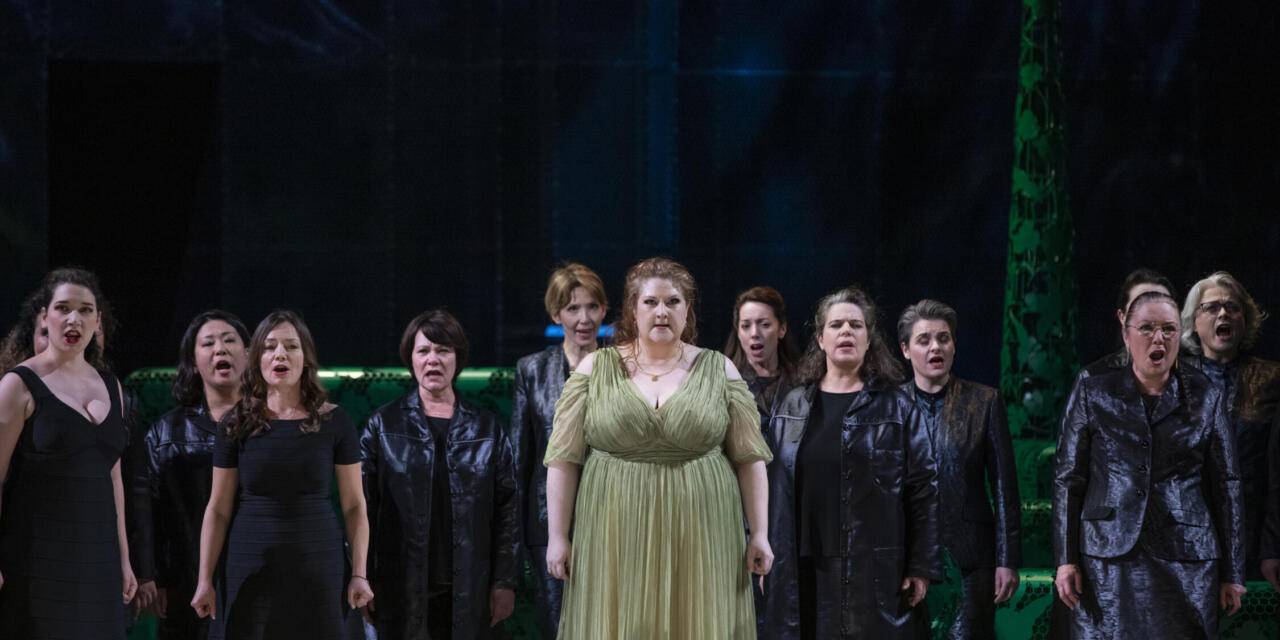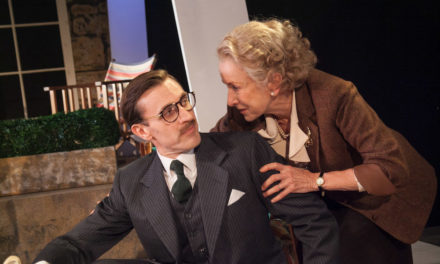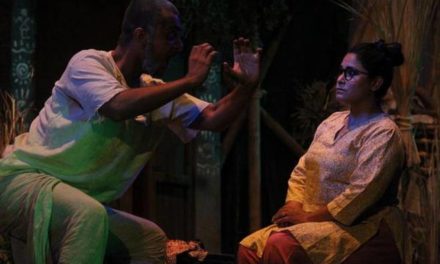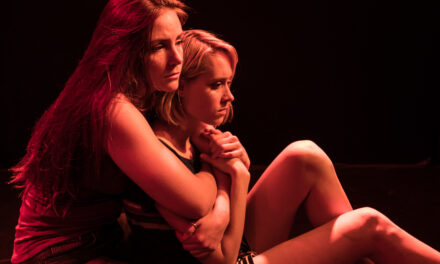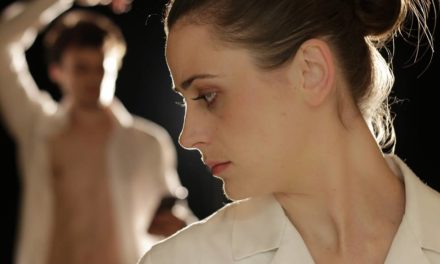Vincenzo Bellini’s penultimate opera, Beatrice di Tenda, rests between two more frequently performed works, Norma (1831) and I puritani (1835) – the latter his eleventh and final opera. Premiered in Venice in 1833, not very successfully, it has been side-lined as a lesser work and has largely languished in the shadow of his better-known operas. Its merits have predominantly been seen to lie in the opportunities proffered for a star soprano to be able to showcase her vocal pyrotechnics: Giuditta Pasta first performed the title role but Joan Sutherland, Leyla Gencer and Edita Gruberová have taken on Beatrice in some occasional twentieth-century outings. The opera remains, however, a rarely produced bel canto work — Italian romanticism that had its moment and then faded from the operatic repertoire in the aftermath of the 1870s.
Enter Peter Sellars, here working for the first time with the Italian repertoire. His staging of Handel’s 1749 oratorio Theodora at Glyndebourne in 1996 demonstrated an acute ability to provide theatrical tension in the staging of a work that was never designated for operatic performance. Here, in a new staging opening at the Opéra Nacional de Paris (Bastille) he confronts the challenges of the work — its length, its long sequences of inaction and introspection, interspersed with graphic reports of torture and physical abuse — head on. The result is a busy, meticulously choreographed production that proves thrillingly contemporary in its ethos and vision. Its strength resides in an ability to fuse its timely resonances with a nod to the broader European revolutionary movements that shaped the climate in which Bellini wrote his final works without ever opting for the literal or the obvious.
The piece’s focus on personal courage and commitment in the face of institutional tyranny certainly fits within a body of stage work where Sellars has consistently asked questions of how power is navigated, where the boundaries of abuse lie and how both individuals and communities challenge despotism in its many manifestations. There are points of contact with earlier Sellars stagings: the rigidity of the title protagonist in Idomeneo (2003), the calculated actions of the complacent Count in Marriage of Figaro (1988), and the clarity of purpose of Theodora. As he demonstrated in Nixon in China (1987), Sellars can find a language for embodying a nation’s way of being with an economy of gesture and imaginative choreography.
In Beatrice, Duchess of Milan, Sellars finds a protagonist as determined as Theodora whatever the authorities – here embodied by her suspicious second husband, Filippo (Quinn Kelsey) — throw at her. Tamara Wilson’s Beatrice is having to manage a husband who has his eyes increasingly set on another. Agnese (Theresa Kronthaler) pines after Orombello (Pene Pati) but finds herself falling into a liaison with Filippo who plans to dispense with both Orombello and Beatrice, on the pretext that they are involved in a romantic liaison. Suspicions here have been planted by the jilted Agnese, jealous of Orombello’s admiration for Beatrice’s charitable ethos.
The action takes place within George Tsypin’s atmospheric set design: a palace garden where transparent towers adorned with lurid electric green painted foliage (suggesting a less than benign pastoral landscape) rest cheek by jowl against a mirrored backdrop wall slightly crumbling in parts. There is nothing realistici in this environment, rather the towers and textures suggest layers of history that have accumulated on the stage. It’s a stage where characters can hide and observe, where they can meet clandestinely and where the different constituencies — Beatrice’s progressive community and Filippo and his allies — rest uncomfortably together. This opaque environment enables Sellars to position the Chorus who preside as judge and jury over the falsely accused Beatrice and her alleged lover Orombello behind and at a distance — almost acting as voices within her husband Filippo’s feverish mind.
In the second act, which resembles a judicial drama, the garden is reconfigured to resemble a courtroom where Filippo presides in the raised centre as judge and executioner, encouraged by the jury of his devoted followers calling for ever more horrific forms of torture to extract confessions from the innocent Orombello and Beatrice.
Filippo’s marriage to Beatrice is shown to be one of convenience rather than affection — at least for him — and the opera opens with his expressions of jealousy at her superior status at Court fuelled by a growing paranoia that she might seek to usurp him. He could perhaps be seen as an early prototype of Verdi’s troubled King Philip II in Don Carlos — rash, absolute and dangerous in his refusal to listen or learn. When Agnese, whom Filippo lusts after, brings him falsified evidence of Beatrice’s infidelity with Orombello, Filippo’s jealous paranoia explodes and both Beatrice and Orombello are cruelly tortured so that they may confess their supposed adultery. Orombello confesses as his body is broken by physical violence, although he later takes back his confession and stands firm in his defence of Beatrice’s virtue. Beatrice’s death is shown as a triumph of innocence and faith in social justice in the face of unjust oppression. Her actions indicate the importance of taking responsiblity — with action trumping rhetoric.
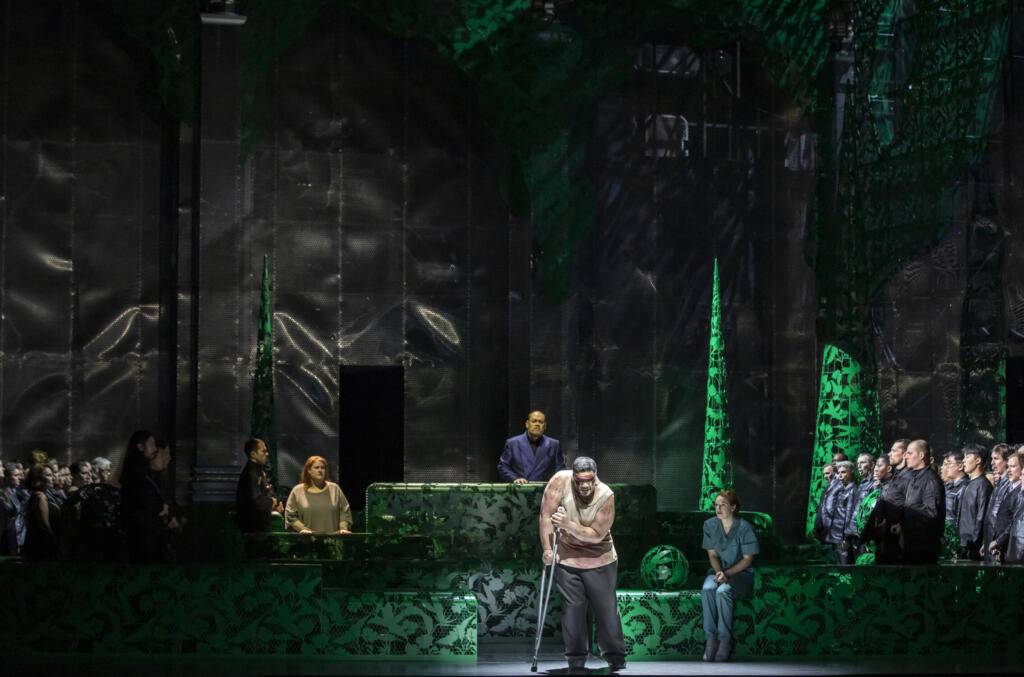
The broken Orombello (Pene Pati) with Filipo (Quinn Kelsey) watching his every move. Photo © Franck Ferville, OnP
If I return repeatedly to the legendary Glyndebourne Theodora, it is because the staging of Beatrice di Tenda is in numerous ways reminiscent of Sellars’ landmark production of Handel’s oratorio, where the protagonist and her lover Didymus go to their deaths to defend their Christian faith against Roman tyranny and persecution. Theodora and Beatrice di Tenda both contain long arias of emotional introspection and debate, something that suits Sellars’ approach to staging. There are many familiar Sellars tropes here: Filippo’s guards carry machine guns, weapons of fear and coercion; Beatrice and Orombello’s supporters share a choreographic lightness that contrasts with Filippo’s thuggish associates. Camille Assaf’s costumes are broadly twenty-first century, emphasising Sellars’ contemporary setting and preoccupation. Long term collaborator James F. Ingalls’ lighting is evocative and precise with an emphasis on the dark and sinister as the disturbing and shocking narrative unfolds. Pockets of action appear on the expansive Opéra Bastille stage, creating a sense of subterfuge and surveillance. The balcony where Agnese watches over the action is the site of misguided observation that offers no ethical perspective or sense of proportion. The physical degradation of Orombello and subsequently Beatrice may not be presented on-stage but, as per Greek tragedy, we are made very aware of the consequences of what happens off-stage. They appear as wounded, bloodied entities. Pati’s Orombello is particularly moving as he tries to balance on crutches unable to sustain his broken body while Wilson’s Beatrice — standing steadfast — carries the blood on a plain sackcloth dress that will become her shroud — a contrast with the delicate, elegant, pleated pale golden-yellow Grecian-influenced dress worn in Act 1. Ingalls’ lighting emphasises their isolation to powerful effect.
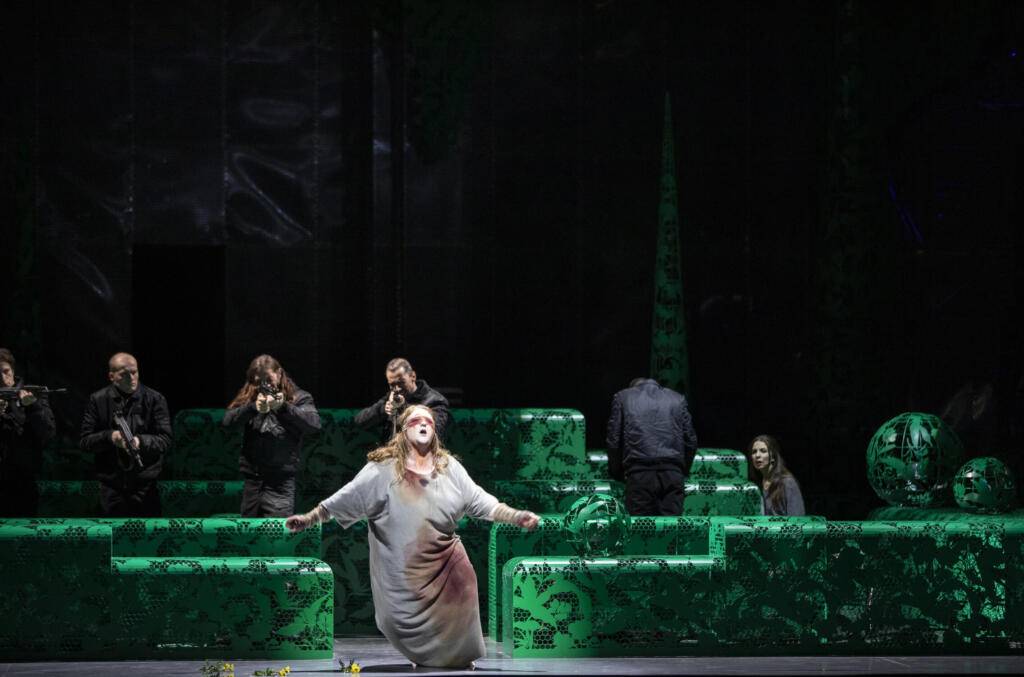
Beatrice (Tamara Wilson) standing firm in the face of death. Photo © Franck Ferville, OnP
Sellars conjures committed performances underpinned with emotional truth and conviction from American Tamara Wilson in the title role, singing with a fearless and totally committed vocal intensity underlining her character’s singular resolve in the face of unjust challenge. Samoan tenor Pene Pati as Orombello provides anguished protestations of innocence that are both formidable and moving. American Quinn Kelsey gives us a compelling picture of Filippo’s calculating arrogance as Beatrice’s jealous husband and the young German soprano Theresa Kronthaler as Agnese sings with beautiful artistry, particularly in her opening aria “Silenzio – E notte intorno”, as she waits for Orombello whom she wrongly assumes is in love with her. Her eventual confession that she implicated Orombello and Beatrice out of jealousy that Orombello loved Beatrice rather than her, is convincingly done. She is no longer the composed figure of Act 1 — her tumbling hair and agitated moves pointing to a torment and guilt that haunts her every move.
British conductor Mark Wigglesworth offers an idiomatic account of the score. Again, he may not be an obvious choice for this repertoire, although his musical leadership of similar titles, including Lucia di Lammermoor for English National Opera in 2018, demonstrate his credentials for this music. The offstage chorus in the second part, placed high and at the top or behind the auditorium works superbly well, underlining their role as voices in the increasingly conflicted Filippo’s head. It also hints at the idea that we, the audience, may also be implicated in the appalling miscarriage of justice that concludes the opera.
Sellars and his creative team make a powerful case for this unjustly neglected title from the mid-nineteenth-century Italian repertoire. It’s a brave production mounted with considerable emotional conviction and confirms Sellars’ continuing position — 43 years after his thrilling 1981 Orlando at The American Repertory Theatre — as one of the most relevant and committed directors working in opera today.
Beatrice di Tenda, a coproduction with the Gran Teatre del Liceu Barcelona, played at the Opéra National de Paris (Bastille) from 9 February to 7 March 2024.
This post was written by the author in their personal capacity.The opinions expressed in this article are the author’s own and do not reflect the view of The Theatre Times, their staff or collaborators.
This post was written by Maria Delgado.
The views expressed here belong to the author and do not necessarily reflect our views and opinions.

